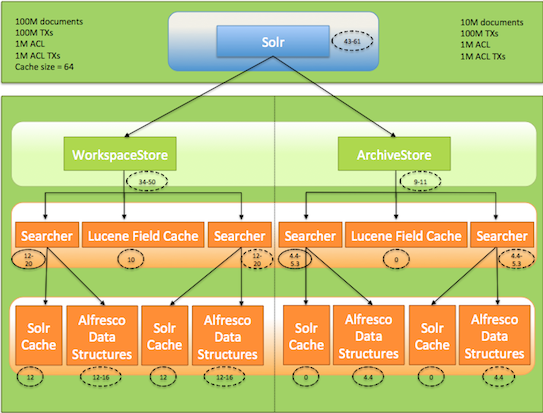By default, there are two cores in Solr 4: WorkspaceSpacesStore and ArchiveSpacesStore. Normally, each core has one searcher but can have a maximum of two searchers.
- N = refers to the number of nodes in the store. Each core's value is calculated separately. If there are more than two cores, you will need to add additional queries to calculate the value for that core (as shown in the example code block).
- T = refers to the number of transactions in the repository and this is same for each core
- A = refers to the number of ACLs in the repository and this is same for each core
- X = refers to the number of ACL transactions in the repository and this is same for each core
select * from (select count( * ) N_SkyVault from alf_node where store_id = (select id from alf_store where protocol = 'workspace' and identifier = 'SpacesStore')) as N1 , (select count( * ) N_Archive from alf_node where store_id = (select id from alf_store where protocol = 'archive' and identifier = 'SpacesStore')) as N2 , (select count( * ) T from alf_transaction ) as T, (select count( * ) A from alf_access_control_list ) as A, (select count( * ) X from alf_acl_change_set) as X;
select * from (select count( * ) N_SkyVault from alf_node where store_id = (select id from alf_store where protocol = 'workspace' and identifier = 'SpacesStore')) as N1 , (select count( * ) N_Archive from alf_node where store_id = (select id from alf_store where protocol = 'archive' and identifier = 'SpacesStore')) as N2 , (select count( * ) N_Version2 from alf_node where store_id = (select id from alf_store where protocol = 'workspace' and identifier = 'version2Store'))as N3 , (select count( * ) T from alf_transaction ) as T, (select count( * ) A from alf_access_control_list ) as A, (select count( * ) X from alf_acl_change_set) as X;
Memory calculation for the SkyVault data structures associated with one searcher
For a store containing 100M nodes, 100M transactions, 100M ACLs and 100M ACL transactions, 20.1 GB of memory is needed. Assuming there are not many ACLs or ACL changes, for 100M nodes, you will need 12 GB to 16 GB of memory depending on the number of transactions. This calculation is based on the following formula: 120N + 32(T + A + X) bytes.
Memory calculation for the Solr 4 caches associated with one searcher
The Solr 4 cache will use up to (2N + T + A + X)/8 bytes for an entry in any cache.
The formula to calculate the total memory needed for the caches for a single core is: (solr.filterCache.size + solr.queryResultCache.size + solr.authorityCache.size + solr.pathCache.size) * (2N + T + A + X)/8 bytes
So, for 100M documents and 100M transactions, 150 GB of memory is needed using the out of box configuration.
(512 + 1024 + 512 + 512)(500M)/8 = 150 GB
The default cache values needs to change to accommodate a large repository. So, for 100M documents, 100M transactions and reduced cache size, 19 GB of memory is needed.
(64 + 128 + 64 + 64)(500M)/8 = 19 GB
- Sorting a large result set
- Long running queries
- Queries with many terms
- Running multiple queries simultaneously
Solr 4 memory planning
solr.filterCache.size solr.queryResultCache.size solr.authorityCache.size solr.pathCache.size
-XX:+UseConcMarkSweepGC -XX:+UseParNewGCThis includes installations where Solr 4 is running on the same server as SkyVault and Share.
Overall Solr 4 memory use
This example is based on the data provided above.
For WorkspaceStore: Assuming that there are 100M docs, 100M TXs, 1M ACLs and ACL TXs, cache size of 64 entries each for FilterCache, AuthorityCache and QCache, and 128 entries for PathCache, between 12 GB to 20 GB of memory is needed per searcher. Normally, there is one searcher live but around commit time there can be two searchers. So, approximately 34 GB to 50 GB of memory will be needed in total.
For Archivestore: Assuming that there are 100M transactions, 10M docs and all caches are tuned down, between 4.4 GB to 5.3 GB of memory is needed per searcher. Total memory needed for both the searchers will be between 9 GB to 11 GB.
So, the total memory requirement for both the cores is between 43 GB to 61 GB.
The following diagram shows the overall memory use for a Solr 4 node as explained in the example:

Minimize the memory requirements for Solr 4 nodes
- Reduce the cache sizes and check the cache hit rate.
- Disable ACL checks using SkyVault.doPermissionChecks=false
- Disable archive indexing, if you are not using it.
- Check the number of empty transactions. If there are many empty transactions, purge the transactions from SkyVault using the action=FIX action.
- Find the exact number of nodes in the store (N), exact number of transactions in the repository (T), number of ACLs (A) and related ACL transactions in the repository (X).
- Since everything scales to the number of documents in the index, add the Index control aspect to the documents you do not want in the index.
